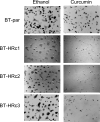Personalizing HER2-targeted therapy in metastatic breast cancer beyond HER2 status: what we have learned from clinical specimens
- PMID: 20300449
- PMCID: PMC2840656
- DOI: 10.2174/187569209790112337
Personalizing HER2-targeted therapy in metastatic breast cancer beyond HER2 status: what we have learned from clinical specimens
Abstract
HER2 is over-expressed in approximately 25% to 30% of human metastatic breast cancers, primarily due to gene amplification. There are currently two HER2-targeted therapies approved for clinical use, the monoclonal HER2 antibody trastuzumab and the EGFR/HER2 dual tyrosine kinase inhibitor lapatinib. Although both agents show clinical benefit in a subset of patients with metastatic breast cancer, many patients with HER2-over-expressing metastatic breast tumors do not respond to these agents. Furthermore, those who do show an initial response generally demonstrate disease progression, on average in less than one year. It has become clear that HER2 expression status alone does not adequately predict response to HER2-targeted therapy. Identification and clinical validation of molecular predictors of response to trastuzumab and lapatinib is critical for further personalizing treatment and improving clinical benefit for patients whose tumors over-express HER2. In this review, we discuss published data describing potential predictors of response or resistance to trastuzumab and lapatinib. While a discussion of the preclinical work is provided, the emphasis is placed on potential predictors that have been studied in clinical specimens such as tumor tissue or serum obtained from patients treated with HER2-targeted therapy. The present analysis and synthesis of the available literature therefore contribute towards an emerging knowledgebase to personalize breast cancer treatment taking into factors including but beyond HER2 expression.
Figures





References
-
- Slamon DJ, Clark GM, Wong SG, et al. Human breast cancer: correlation of relapse and survival with amplification of the HER-2/neu oncogene. Science. 1987;235(4785):177–82. - PubMed
-
- Chen FL, Xia W, Spector NL. Acquired resistance to small molecule erbB2 tyrosine kinase inhibitors. Clin Cancer Res. 2008;14(21):6730–4. - PubMed
-
- Sauter G, Lee J, Bartlett JM, et al. Guidelines for Human Epidermal Growth Factor Receptor 2 Testing: Biologic and Methodologic Considerations. J Clin Oncol. 2009;27(8):1323–33. - PubMed
-
- Baselga J, Tripathy D, Mendelsohn J, et al. Phase II study of weekly intravenous recombinant humanized anti-p185HER2 monoclonal antibody in patients with HER2/neu-overexpressing metastatic breast cancer. J Clin Oncol. 1996;14(3):737–44. - PubMed
Grants and funding
LinkOut - more resources
Full Text Sources
Research Materials
Miscellaneous
